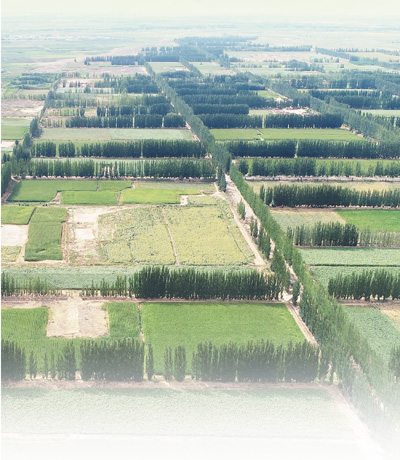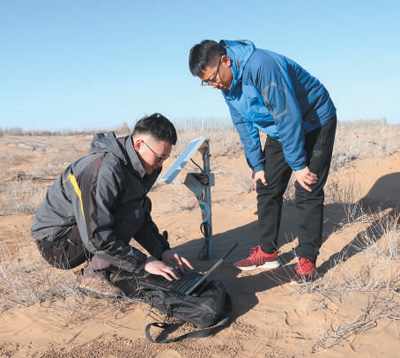China's Inner Mongolia promotes science-based desertification control
 2023-07-29
2023-07-29
 People.cn
People.cn
The forest coverage rate in Dengkou county, Bayannur city, north China's Inner Mongolia Autonomous Region has now exceeded 37 percent, an increase of more than 900 times from the 1950s.

The Experimental Center of Desert Forestry under the Chinese Academy of Forestry (CAF) in the county where the Ulan Buh Desert is located has played a vital role in "forcing sand to retreat" with science-based desertification control.
In 1979, China designated 470,000 mu (31,333 hectares) of land as experimental zones for research on desertification prevention and control in the county. The center has since built four experimental fields on the fringe of the Ulan Buh Desert.
Since the 1990s, the center began to promote the building of farmland shelterbelts made up of main tree belts and secondary tree belts for desertification control, with each tree belt consisting of two rows of poplars, according to Jia Yukui, a senior engineer at the center.
Relying on researchers' calculations and research results for years, this new model replaced the traditional one with each tree belt consisting of eight rows of poplars.
For the new model, the tree spacing of farmland shelterbelts is 1 meter, and the distance between two shelterbelts is 12 to 18 times the predicted height of trees, said Wang Zhigang, the center’s chief engineer.
Wang explained that the new model ensures less occupation of farmland and the fast growth of trees. Compared with the traditional one, the new one can achieve a better effect in desertification control.

Researchers from the Experimental Center of Desert Forestry under the Chinese Academy of Forestry (CAF) collect soil moisture data in Dengkou county, Bayannur city, north China's Inner Mongolia Autonomous Region. (Photo courtesy of the Experimental Center of Desert Forestry under the CAF)
Thanks to the building of farmland shelterbelts, the center has created a 20,000-mu oasis out of sandy wasteland. The farmland shelterbelt model has been applied to over 560,000 mu of land in Dengkou county.
In addition to farmland shelterbelts, the center and people in the county have created grass belts and sand-fixing shrubs on suitable land, said Zhang Rui, the director of the department of resource conservation of the center.
Consequently, Dengkou county has built a complete shelter forest system that includes grass belts, sand-fixing shrubs, farmland shelterbelts, and protected areas including a national nature reserve and a national wetland park.
Selecting suitable tree varieties is key to the building of shelter forests. Wang's team bred a new poplar variety that helps reduce the emergence rate of longicorns, which pose a threat to poplars, to only 0.25 percent, Wang said.
In 2019, Wang's team was granted a certificate of improved tree variety and began to promote the planting of the new poplar variety in some areas in northwest China. The team has also been making efforts to breed more improved poplar varieties.

A researcher from the Experimental Center of Desert Forestry under the Chinese Academy of Forestry (CAF) maintains a dust storm observation tower in Dengkou county, Bayannur city, north China's Inner Mongolia Autonomous Region. (Photo courtesy of the Experimental Center of Desert Forestry under the CAF)
Many research results of the center, including the new poplar variety, have been promoted. Having been engaged in desertification control research, the center has set an example in desertification control, with many achievements being promoted in the Ulan Buh Desert and other sandy areas across China, said Lu Qi, chief scientist of the CAF and former director of the center.
In recent years, China launched the construction of a germplasm bank of sea buckthorn, a type of sand-adapted shrub whose fruits are known for their high nutritional value by relying on the center, an important research hub for sea buckthorn in China.
The center has cultivated many high-quality sea buckthorn varieties, which have been planted on a large scale in Inner Mongolia and northwest China's Xinjiang Uygur Autonomous Region.
"We are working on ways to increase the oil and flavonoid content of sea buckthorn fruits, thus helping cultivate new varieties of sea buckthorn that are more suitable for deep processing and have higher economic value," said Song Yating, a postgraduate student at the CAF in Beijing, who recently worked at the center.
The center has collected the germplasm resources of several plants that can grow in sandy soil, including sacsaoul, Korshinsk pea shrub, and Ammopiptanthus mongolicus. The center will continue to collect such germplasm resources and share them with other domestic researchers to promote the protection and sustainable utilization of plants that can grow in sandy soil.
It has monitored relevant data for desertification control since it was built more than four decades ago.
It has built four dust storm observation towers, with each installed with vessels for collecting dust and sensors that monitor wind speed, wind direction, humidity, radiation and other parameters.
Jia said monitoring data showed that large-scale afforestation projects significantly improved the local environment. For instance, the projects can reduce water evaporation by 30 to 40 percent around July.
Not far away from an observation tower in the center, there is an automatic sprinkler system built over a sand dune growing with Nitraria tangutorum, a typical desert shrub. Researchers monitor the growth conditions of the shrub by setting up different volumes of water for the plant.
Predicting the growth of vegetation in arid areas under the trend of aggravated changes in global wetting and drying is of great significance to science-based desertification control in the future, said Jia.




